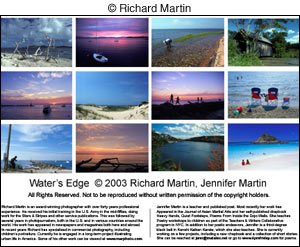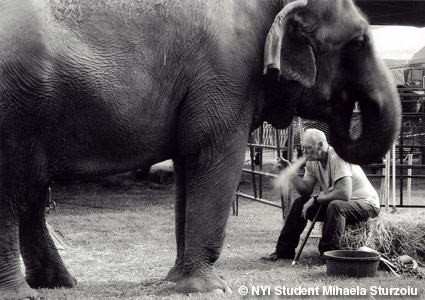Readers will notice that this two-part series on photo tips for visitors to New York City was written prior to the September 11 attack that demolished the World Trade Center. Perhaps we will rewrite these articles in the future to remove mention of the Twin Towers and images that show them. But not right now. The 110-story towers were part of New York's skyline for almost thirty years, and we don't feel that it's imperative to erase them, or their remarkable place in the skyline of lower Manhattan just yet.
As most readers of this piece also know, there's been a dramatic drop-off in tourism in New York City since September 11. New York City is still a great place to live and work, and to visit. We hope these tips whet your appetite. When you see the World Trade Center in a photo here or there in these articles, take a moment to reflect on the bravery so many showed in an effort to rescue the innocent and unsuspecting victims of this horrible attack. New Yorkers will never forget the victims and will remain forever grateful to all who assisted in the rescue effort.
This article is for anyone planning a visit to New York City who wants to take great travel photos of the Big Apple. In Part One, we gave you tips for photographing all the top sites in Lower Manhattan. Now, we're going to turn our camera to the top sights in mid-Manhattan. Next month, for those with a little extra time and a hankering for adventure, we'll close this series with some tips for exciting places to visit that offer great photo opportunities a little further afield in the New York area.
STOP ONE: TIMES SQUARE
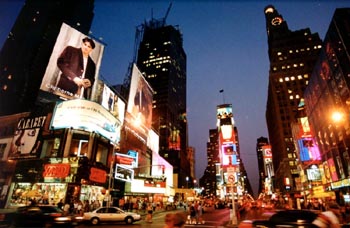
For many tourists, and for many New Yorkers as well, Times Square is ground zero for New York.
WARNING! If you haven't been to Forty Second Street in the past four years or so, you're in for a shock. "The Deuce" as its denizens used to call it, has been cleaned up in the past few years, and even old-time New Yorkers are amazed when they visit this work-in-progress.
From 42nd to 47th Street, with Broadway and Seventh Avenue running through it, Times Square is really a series of several small, open squares rimmed by New York's theater district to the west, and giant hotels and skyscraper office buildings on all sides. These buildings are the foundation that supports the biggest concentration of bright lights in the Big Apple - the logos, neon signs and billboards of Times Square.
While there's a growing presence of Disney and Theme-Park Cafes, there's still a lot about this area that represents the real New York. Just a few years ago the area was a little seedy, but now all of Times Square is a safe, fun place to visit.
PHOTO TIP: For great photos, the best time to visit Times Square is at twilight. Here's why: During the day, a lot of the bright lights aren't on, so they won't show up in your photographs. After nightfall, when it gets really dark, the sky and the outline of the towering buildings will get lost in your photos and only the lights will be visible. For the best results, you want to catch both the bright lights and a sense of the buildings that rim the Square.
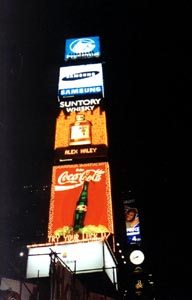
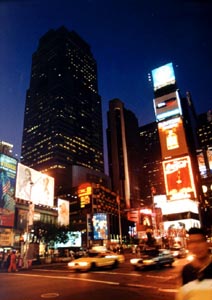
If you've come from another time zone, check at the hotel front desk or in the daily newspaper to see what time the sun will actually set.
Point-and-Shoot Tip: If you want to photograph your travel mates against the bright lights of Times Square, the trick is to fire your flash to light up your friends but still have a long enough exposure time to record the lights and signs that tower above the Square. That's easy enough with a single lens reflex (SLR) where you can control the shutter speed.
Even if your SLR synchronizes with flash at 1/125 or 1/60 of a second, try setting your shutter speed to 1/30. Even if you're shooting with a point-and-shoot, you may have some control. Some point-and-shoot models have an extra flash setting that looks something like this:
Cameras that feature this program will fire the flash to put light on the subjects in the foreground, but still give a little added overall exposure to make sure the lights in the background show up in your photo.
Tip for Everybody: Time-and-again we see amateur photographers make the same mistake when they pose their friends for a picture in Times Square. Their intended subject is actually two subjects, their friends and the bright lights. To to fit both subjects in the frame the photographer backs away from the group fifteen or twenty feet in order to include a tall building covered with bright lights behind the group of tourists.
Big mistake! This puts the people too far away from the little on-camera flash. Result: They don't get enough light on them. Also, the second subject of the photo, the bright lights, gets diluted by the excess dark space in the picture - after all, even in Times Square there aren't bright lights everywhere.
The solution: Kneel down and shoot from a low angle. That way, the two subjects -- your friends and the bright lights behind them -- can be packed into a much tighter frame. There will be enough light on the people, and lots of lights right behind their heads.
If possible, have your subjects pose by dropping their heads ever so slightly, or leaning over a little bit, so you don't shoot right up their noses.
Around Times Square
In addition to the signs, the bright lights and the other displays, Times Square is an exciting, crowded place. The streets are filled with thousands of tourists who have come to see the sights, out-of-towners and New Yorkers alike who have come to attend the theater or the many movie houses that abound in the area, or just to people watch. Plus, thousands of New Yorkers work in those big office buildings.
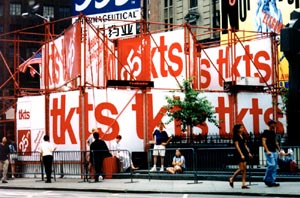
Entertainment tip: If you want to see a live show while you're in New York, there's a discount booth called "TKTS" for same-day theater tickets at the north end of Times Square at 47th Street. There are often great deals available for many Broadway shows.
Through the cross streets in the Forties, you can venture west to Eighth Avenue and beyond toward Ninth Avenue where you will find some interesting small restaurants. Specialty food shops line Nineth Avenue from about 50th Street south to 36th Street. Many exotic foods and spices can be found in the storefront markets.
STOP TWO: FIFTH AVENUE, ROCKEFELLER CENTER AND ST. PATRICK'S CATHEDRAL
Start at 50th Street and Fifth Avenue. To the west of Fifth Avenue is Rockefeller Center, on the east you'll find St. Patrick's Cathedral and Saks Fifth Avenue Department Store.
Rockefeller Center is best known for its Christmas Tree and skating rink, but it's a pleasant place to visit and a great place to photograph all year round.
In fact, the annual first lighting of the Christmas tree has become such a big event that it creates an incredible jam and most people can't get within sight of the tree. If you're in town on that early night in December, do what we do and watch it on television.
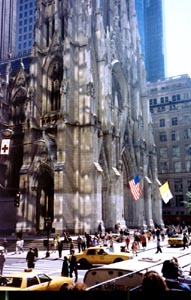
St. Patrick's Cathedral, at 50th Street, is an elegant church complex. New York's Cardinal lives behind this figurehead Catholic Church.
Evenings, a walk up Fifth Avenue takes you past the best-known luxury stores of swank New York. The most inventive displays of high fashion are always on view in the store windows at Saks and Bergdorf Goodman at Fifth Avenue and 57th Street. Along the way, stop and see what's for sale at Tiffany and Cartier.
Shopping Tip: When you're on the west side of Manhattan, you're within striking distance of America's biggest photography store -- B & H Photo and Video, which moved a year ago to 420 Ninth Avenue, between 33rd and 34th Streets.
Over the past twenty years, B&H has grown to become the biggest outlet for photography gear for pros in New York and, thanks to their large mail order operation, for serious photographers from all over the United States and around the world. They have succeeded in providing good prices and reliable service. A year ago, they finally moved from their former cramped quarters in lower Manhattan to their current state-of-the-art store.
Whether you're in the market for a piece of new equipment or not, you should plan to visit the store. We particularly like their well-stocked used equipment department. We've talked to a host of photo experts, and everyone agrees that in terms of size and stock, there's nothing like B&H anywhere else in the United States. Yodobashi Camera in Tokyo comes close, but B&H is unlike anything we've ever seen.
As with any shopping recommendation we make, we have no relationship with B&H and receive no consideration for mentioning them. When we shop there, we pay the same prices you do. Our acknowledgement is sincere, they've earned it.
STOP THREE: THE EMPIRE STATE BUILDING.
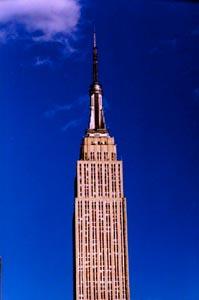
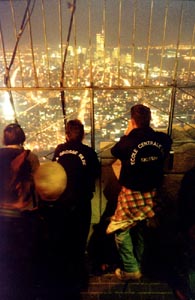
The two tall buildings that most visitors hanker to visit when they come to New York are the World Trade Center and the Empire State Building. Although it's older and not as tall, we favor the Empire State Building because you can get outdoors right in the middle of the city. While the location of the World Trade Center is very dramatic, perched alongside New York harbor, the Empire State Building is our favorite.
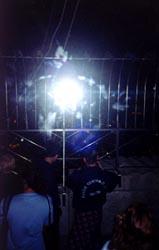
To take dramatic night-time photos off the top of the Empire State Building, we suggest you turn off your on-camera flash and find a way to steady your camera before you shoot. We're always amused when we look up at the top of the Empire State Building at night and see the flashes popping on tourist's point-and-shoot cameras. The flash won't light up the cavernous New York streets, and it will probably cause the camera to underexpose the lights of the city.
We repeat, turn off your flash and steady your camera.
One final point -- go outside to take the photo. If you shoot from the glassed-in portion of the observation area, this is what you're likely to get.
In conclusion...
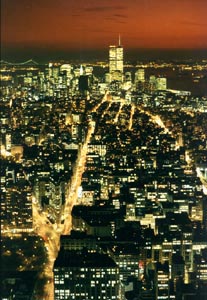
There are lots of interesting things to see and photograph in mid-Manhattan. We've covered the key tourist locations and tried to pass along some tips that will help you avoid the pitfalls we see tourists making every single day. We haven't covered the sky scrapers of Sixth Avenue or the attractions of Central Park, or a host of other topics. Next month, we'll take you to some other locations around town.
Until then, remember what we said in the first section of this article. New York City is a great place to visit, the people are friendly and for the most part helpful, and it's easy to get around town. Just recently, figures were announced that established that 1997 was the biggest year for tourism in New York City's history. Well over 30 million people came to visit us. Come and join the fun!


